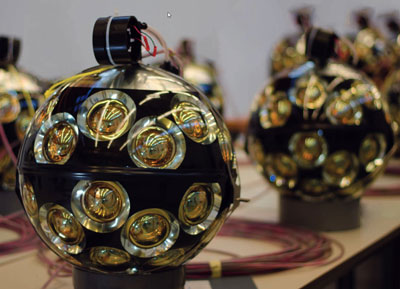Deep beneath the cool and beautiful waters of the Mediterranean Sea, an international collaboration of particle physicists is building a telescope.
“Most telescopes look at light coming from the sky, and they look upwards to the sky,” Paschal Coyle told Eos. “Our telescope searches for neutrinos and, in fact, looks downwards through the Earth and sees the sky on the other side of the Earth.”
Coyle is an astroparticle physicist at the Marseille Particle Physics Center in France and the physics and software manager for the Cubic Kilometer Neutrino Telescope (KM3NeT). When complete, the array of KM3NeT detectors will turn more than a cubic kilometer of the Mediterranean Sea into a giant net to catch neutrinos in action.
How to Catch a Ghost
Every second of every day, 100 billion neutrinos pass through each square centimeter of your body at nearly the speed of light. These “ghost particles” are born in the hearts of stars, in supernovas, in chemical reactions, and in Earth’s atmosphere.
The best thing about neutrinos is also the worst thing about them, according to Coyle. “They hardly interact with anything,” he said. “They always move in straight lines, and they don’t get absorbed by dust clouds or other objects in the way. With neutrinos, the idea is that we be able to see to the edge of the universe.”

But because they travel almost unimpeded, neutrinos are notoriously difficult to detect. “The only way to do it is to build an absolutely ginormous telescope,” Coyle said.
“The sea is kind of the perfect net for neutrinos,” he said. Very rarely—less than one in a million—a neutrino will collide with a water molecule and produce a nanosecond flash of blue light, called Cherenkov radiation. “We put all these ultrasensitive light detectors at the bottom of the sea, and they sit there and wait to catch the flashes of light made by the neutrinos,” Coyle explained. “The reason we’re in the sea is because it’s big, it’s dark, and it’s very transparent. When we get the flash of light, it doesn’t get absorbed” by the seawater.
Under the Sky and the Sea
KM3NeT’s hundreds of optical detectors will form underwater 3-D grids near the French and Italian coasts. A few detectors are strung together, and strings are dropped vertically into the water at evenly spaced intervals. Each grid will span a kilometer in every direction and will live thousands of meters under water. The video below shows the deployment of one string of detectors.

KM3NeT will have a big scientific impact beyond the field of particle physics, according to Coyle. “To do our measurements with the neutrinos, we need to know the optical transmission of the seawater, the temperatures, and the sea currents. So we have very precise monitoring of the properties of the sea in the vicinity of the telescope.”
“If anything was to suddenly change in the sea, we’d probably be one of the first to notice it,” he added.
KM3NeT is collaborating with oceanographers, seismologists, and biologists, who will make use of its infrastructure. “Essentially, they can have continuous, long-term, high-frequency sampling in situ at the bottom of the sea,” he said.
Other scientists will use the telescope’s power and data cables to support autonomous submarines and crawlers. Projects to sample seafloor sediment, study bioluminescence, and measure carbon dioxide and oxygen content underwater are also in the works.
And KM3NeT’s hydrophones, which it uses for acoustically locating its detectors, pick up other noises, too. “We listened to all the dolphins and the whales around the telescope.” Coyle said.
“A Tour de Force of Technology”
KM3NeT is in its early stages of deployment. There are a few operational detectors at the first site off the coast of Sicily and others near Toulon, France, that deployed this year. The team is also exploring a potential third site near Pylos, Greece. Full deployment of the array is expected to take at least 3 more years, but the telescope has already detected some neutrinos.

Despite the scale of the project, the engineers took care to build a telescope that could withstand the tough conditions at the bottom of the Mediterranean while also minimizing its environmental impact.
“We’re very careful. There’s nothing toxic, nothing really dangerous” used in the detectors, Coyle said. “We have to take a lot of care that all the materials we use can withstand the high pressure…and doesn’t corrode in the seawater.”
“We don’t have a lack of technical challenges,” he said. “It’s quite a tour de force of technology.”
—Kimberly M. S. Cartier (@AstroKimCartier), Staff Writer
Citation:
Cartier, K. M. S. (2019), An underwater telescope to study sky and sea, Eos, 100, https://doi.org/10.1029/2019EO126977. Published on 25 June 2019.
Text © 2019. AGU. CC BY-NC-ND 3.0
Except where otherwise noted, images are subject to copyright. Any reuse without express permission from the copyright owner is prohibited.

